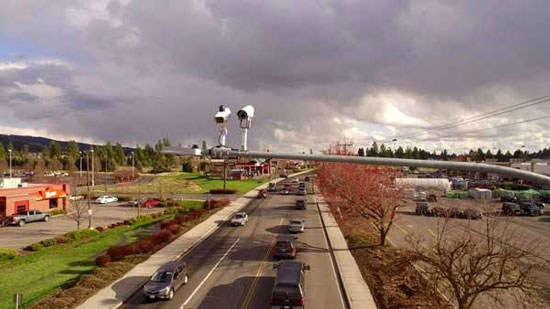Edge computing is still a relatively new development and is currently constrained by a lack of established architectures and standards and available products designed specifically for supporting edge applications. This, however, is changing, and we are now seeing lots of innovation around these areas. Moreover, commercial edge computing products — including hardware solutions featuring embedded analytic and artificial intelligence (AI) technologies — are just now starting to become available or will be soon. Despite these hindrances, we are seeing examples of companies developing edge computing applications.
Locomotive Optimization at GE Transportation
GE Transportation offers a good example of a company applying edge-based analytics in an Internet of Things (IoT) scenario; in this case, to analyze data from locomotives and uncover use patterns, which are then applied to optimize train operations.
Modern locomotives can feature more than 200 sensors designed to monitor a range of operating parameters — everything from engine performance and cooling systems to wheel, axle, and truck assemblies — all of which can generate millions of data points and instructions per second. Sending all this data to the cloud for processing and analysis is not practical, nor is it necessary or cost-effective. Consequently, GE has been equipping its locomotives with edge devices that implement streaming analytics designed to collect and analyze data locally and apply algorithms (locally) to allow responses to changes in that data. The goal is to operate the locomotive more efficiently to improve safety, uptime, and costs.
The analytics and platform architecture are based on GE’s Predix Machine and Predix Edge Manager platforms. Predix facilitates connecting devices and machines and analytical processing in real time across distributed machines and data, over deterministic networks, and via the embedding of analytics within machines to make them more intelligent. The Predix platform is augmented with SAS’s Event Stream Processing System, which allows the application to analyze high volumes of data streaming from onboard sensors.
GE Transportation’s initial rollout involves implementing edge analytics devices in more than 1,000 locomotives in North America.
AI, Cognitive, and ML on the Edge
We are also seeing the use of AI technologies like cognitive systems, predictive analytics, and other machine learning (ML) technologies applied to edge computing in IoT scenarios that demand intelligent, real-time analytics capabilities.
Companies developing computer vision systems were some of the first to offer solutions that embed AI technologies on-device or close to the edge of the network. A good example is Echelon, which uses cognitive and ML-based vision technology in its connected outdoor lighting systems designed to support smart cities’ IoT use cases. Echelon’s intelligent vision devices perform collection and analysis of data at the edge of the network instead of on a central server, minimizing demands on network bandwidth. The lighting platform provides an architecture that enables faster decision making in response to changing conditions. The goals are to: (1) reduce energy and operational costs, (2) improve safety and comfort, and (3) optimize physical lighting systems.
These cognitive visioning and lighting systems are used in various smart city scenarios. For instance, deployed on streetlights near intersections, they can analyze traffic flows and automatically adjust light levels accordingly, triggering higher levels during peak volumes and lower levels during non-peak periods (see Figure 1).

Figure 1 — Echelon’s InSight Cognitive Vision System.
ML at the Edge for Industrial Manufacturing
DAIHEN, of Osaka, Japan, has been deploying industrial sensors in combination with edge computing software and ML to optimize the manufacture of its industrial transformers. The company claims that by automating the monitoring and analysis of production and quality control data and team processes, it has eliminated almost 5,000 hours of manual data entry per year.
The application is built on top of an RFID tracking system that collects data from various devices for measuring materials and production conditions — including temperatures, humidity, and dust levels across the manufacturing process, as well as production team efficiency metrics. The data is analyzed to determine how each part of the electric transformers is assembled and to monitor how long it takes to complete each stage in the production process. Previously, monitoring and logging this information was done manually and was time-consuming. To overcome this latency, DAIHEN deployed edge intelligence software from FogHorn to automate monitoring of the overall electric transformer manufacturing process.
FogHorn’s LightningEdge ML application allows ML models to run on highly constrained devices, including sensor-based systems operating on manufacturing equipment and other industrial platforms. By ingesting and analyzing specific data from these sensors, the ML models can deliver real-time insights into changes that could impact the quality of manufactured components. In addition, engineers can visually analyze the data during the manufacturing process, allowing them to spot production errors.
DAIHEN reps claim that the application currently covers 70% of its Osaka factory, with plans to eventually expand this to almost 100% of plant operations. In addition to significantly decreasing manual data entry requirements, the application also improves the quality of sourced data.
Remote Monitoring and Predictive Maintenance of Oil Field Well Pumps
Oil and gas companies can have thousands of pumps involved in oil field operations, and these pumps can be spread over large geographic areas. Basic IoT connectivity allows companies to monitor and configure oil field pumps remotely so that they only need to send technicians out into the field for repairs once a pump component has actually failed. Schneider Electric, however, wanted to take its Realift Rod Pump Control connected oil pump-monitoring and management platform to a higher level by giving it the ability to predict problems in advance, thereby allowing human operators to take corrective measures before a situation would lead to well pump damage or shutdown.
Schneider developers used the Microsoft Azure Machine Learning platform to develop ML models and Azure IoT Edge to package and deploy them in the Realift Rod Pump Control network architecture. Basically, Azure IoT Edge containerizes cloud workloads — such as ML, streaming analytics, complex event processing, and image recognition — so they can run locally on connected devices and industrial gateways.
The addition of ML capabilities gives Realift the ability to analyze multiple readings from pump-control mechanisms in order to identify patterns characteristic of normal operational performance and anomalies indicative of future pump mechanical component failure. In instances of the latter, a human operator can use this information to modify the pump’s operating parameters in order to delay equipment failure or to shut down the pump in order to avoid possible damage altogether. Technicians also use such findings to develop work plans for optimally servicing the pump. In short, adding predictive capabilities to pump monitoring and maintenance helps protect pumping equipment from possible damage, reduces downtime and negative impacts on oil field productivity, and lessens the risk of environmental damage and potential lawsuits.
[For more from the author on this topic, see “Intelligence at the Edge of IoT.”]



